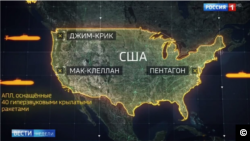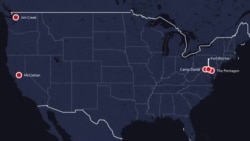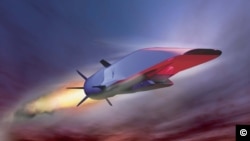Russian television host Dmitriy Kiselyov attempted to clarify what President Vladimir Putin meant when he threatened the United States with retaliation during his annual address to the Federation Council, the Russian parliament. Putin declared that should Washington deploy intermediate-range missiles in Europe, Russia would be forced to strike at key “decision-making centers” in the United States. He then spoke of Russia’s progress in developing a hypersonic missile, the Tsirkon, which Moscow claims would have a range of 1,000 km and move with a speed of 11,000 km.
Russian TV host and CEO of the Kremlin’s media arm Rossiya Segodnya, Kiselyov, who is reportedly close to Putin, was quick to identify the U.S. military “decision-making centers” located along the East and West coasts. But he blundered, listing nonexistent military bases as Russian targets and Kremlin spokesperson Dmitriy Peskov immediately distanced the government from war scenarios presented on its own state-owned television outlet.
“We never interfere and cannot interfere in the editorial policy of our television channels, even the state ones. Therefore, in this case, the question must be addressed directly to the television channels,” said Peskov.
Kiselyov listed the Pentagon as the defense department’s headquarters and Camp David, as the command center of the U.S. president and the Joint Chief of Staff..
But the remainder of Kiselyov’s list seems to not have been updated for at least two decades. Two of the military facilities he named were closed more than twenty years ago and he misrepresented the functions of the third base.
Kiselyov claimed that the U.S. military decision-making centers are “Fort Ritchie, Maryland, the command post of the American President and the command center for the Joint Chiefs of Staff. On the West Coast is McClellan (California), where is the command center of the strategic offensive forces, and Jim Creek (Washington) hosting the nuclear command control center.” He then described in detail how Russia’s prospective hypersonic missile, the Tsirkon, would “eliminate them in seconds.”
Fort Ritchie – Closed
The former U.S. military base Fort Ritchie was closed in September 1998 pursuant to the 1995 Base Realignment and Closure Commission. It is now a census-designated location in Washington County, Maryland, with a population of 314 according to the U.S. Census tabulations for State of Maryland in 2010.
The Maryland National Guard built Camp Ritchie in 1926 as a training ground. During World War II, it was designated as a War Department Military Intelligence Training Center, where 20,000 intelligence troops were housed and trained over a four-year period. From 1964 to 1975, the post was used as a support installation and eventually headquarters for the 7th Signal Command. In 1995, Fort Ritchie was placed on the Base Realignment and Closure (BRAC) list; all military activity ceased by 1998.
The base was never “a command center of the President of the United States and the Joint Chiefs of Staff,” as Kiselyov claimed. But the TV host apparently failed to check the status of the former base before announcing the Russian target in Maryland.
McClellan Air Force Base – Closed
Kiselyev made the same blunder in naming the former McClellan Air Force Base, located near Sacramento, California, which has been closed for 18 years. In fact, it has been converted to a public airport general aviation airport.
“As is part of McClellan Park, Sacramento McClellan Airport is one of the most successful conversions of a former military base in the country,” says the airport’s website.
The Pentagon slated McClellan Air Force Base for closure in 1993, after serving as the pivotal supply depot on the West coast during World War II and later as one of the five repair and maintenance depots for military aircraft. The Air Force base provided major logistical repair and maintenance support for the Korean War, Vietnam War, and Operation Desert Shield/ Storm.
But McClelland was never a “command center of the strategic offensive forces” of the United States as Kiselyov claims, although it employed 4,250 military personnel and 17,652 civilians at the height of the war effort.
'Jim Creek' – Naval Radio Communication
Kiselyov’s last gaffe was to claim that Jim Creek is a nuclear command control center. The base actually consists of the Jim Creek Naval Radio Station and a recreation park for military personnel. The radio station is as a very low frequency (VLF) radio transmitter facility with its main mission to communicate orders one-way to submarines of the Pacific fleet while submerged. Its daily functions are controlled by the Naval Computer and Telecommunications Area Master Station (NCTAMS) Pacific Command.
The local newspaper in the area, the Seattle Times, describes it as “a relatively obscure U.S. military site” in an article about the Kiselyov broadcast.
In 1953, when the Naval Radio Station Jim Creek was dedicated, it was recognized as the most powerful radio station in the world.
“Today it is still among only a handful of radio stations capable of providing more than one million watts of power, allowing the U.S. Navy to communicate with ships, submarines, and aircraft anywhere around the world,” according to Homeport Northwest, the official blog of the U.S. Navy in the Pacific Northwest.
While the radio station is indeed a strategic installation, critical for U.S. Navy in the Pacific, it is not “a nuclear command center,” as Kiselyov claimed.
In the “Nuclear Matters Handbook 2016,” which is online and available to the public, the Department of Defense lists fixed command centers at the Pentagon and an Air Force base in the State of Nebraska as part of the Nuclear Command and Control System. The Jim Creek radio location is not listed.
Kiselyov, however, went on to describe how the prospective Russian Tsirkon hypersonic missile — which is still in development with no clear project completion date — could destroy those American command centers in five minutes. He said that 40 Tsirkons could be mounted on any Russian ship or submarine and launched from 200 miles away in the ocean, just beyond the U.S. territorial waters and target those "command centers."
Internet users noted, however, that the images Kiselyov used to illustrate the Tsirkon are very similar to those of the X-51 missile developed by the American company Boeing.
According to Interfax, Russia conducted several tests of the Tsirkon in 2015, but open sources do not include any official images or video recordings of this missile.
As to Dmitriy Peskov’s separate claim that the Kremlin does not call the shots at state-owned media, that could certainly be a subject of a separate fact check. The last Freedom House report on press freedom in Russia says that “Television, which is still the leading source of news and information, often functions as a propaganda tool for the government.”










